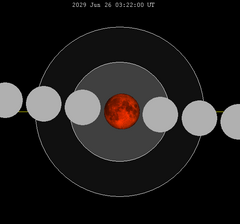July 2065 lunar eclipse
| Total eclipse | |||||||||||||||||
 | |||||||||||||||||
| Date | 17 July 2065 | ||||||||||||||||
|---|---|---|---|---|---|---|---|---|---|---|---|---|---|---|---|---|---|
| Gamma | −0.14023 | ||||||||||||||||
| Saros cycle | 130 (30 of 71) | ||||||||||||||||
| Totality | 97 minutes, 43 seconds | ||||||||||||||||
| Partiality | 217 minutes, 1 seconds | ||||||||||||||||
| Penumbral | 331 minutes, 43 seconds | ||||||||||||||||
| |||||||||||||||||
A total lunar eclipse will take place on July 17, 2065. The lunar eclipse will last 1 hour and 37 minutes, and the umbra will completely cover the moon. While the visual effect of a total eclipse is variable, the Moon may be stained a deep orange or red color at maximum eclipse.[1] The partial eclipse will last for 3 hours and 36 minutes in total. This eclipse will be a central eclipse; this means the center of the umbra will pass on the moon.[2][3]
Visibility
[edit]This lunar eclipse will be visible at moonset over Siberia, Japan, the Pacific Islands, and New Zealand. It will be fully visible over most of East and Central Asia, Australia, and Antarctica. Europe, Western Asia, and East Africa will see the eclipse at moonrise. North and South America will not see this eclipse.
Related lunar eclipses
[edit]Saros series
[edit]Lunar saros series 130, repeating every 18 years and 11 days, has a total of 71 lunar eclipse events including 56 umbral lunar eclipses (42 partial lunar eclipses and 14 total lunar eclipses). Solar Saros 137 interleaves with this lunar saros with an event occurring every 9 years 5 days alternating between each saros series.
| Greatest | First | |||
|---|---|---|---|---|
 The greatest eclipse of the series will occur on 2029 Jun 26, lasting 102 minutes.[4] |
Penumbral | Partial | Total | Central |
| 1416 Jun 10 | 1560 Sep 4 | 1921 Apr 22
|
1957 May 13
| |
| Last | ||||
| Central | Total | Partial | Penumbral | |
2083 Jul 29
|
2155 Sep 11 | 2552 May 10 | 2678 Jul 26 | |
| 1903 Apr 12 | 1921 Apr 22 | 1939 May 3 | |||

|

|

|

|

|

|
| 1957 May 13 | 1975 May 25 | 1993 Jun 4 | |||

|

|

|

|

|

|
| 2011 Jun 15 | 2029 Jun 26 | 2047 Jul 7 | |||

|

|

|

|

|

|
| 2065 Jul 17 | 2083 Jul 29 | ||||

|

|

|

| ||
Half-Saros cycle
[edit]A lunar eclipse will be preceded and followed by solar eclipses by 9 years and 5.5 days (a half saros).[5] This lunar eclipse is related to two annular solar eclipses of Solar Saros 137.
| July 12, 2056 | July 24, 2074 |
|---|---|

|

|
Eclipse season
[edit]This eclipse occurs in an eclipse season. An eclipse season is the period that happens every 5-6 months in which eclipses can occur. This eclipse season has 2 solar eclipses and 1 lunar eclipse.
| July 3, 2065 | July 24, 2074 | August 2, 2065 |
|---|---|---|

|

|

|
See also
[edit]Notes
[edit]- ^ "NASA - Danjon Scale of Lunar Eclipse Brightness". eclipse.gsfc.nasa.gov. Retrieved 2024-09-24.
- ^ "EclipseWise - Total Lunar Eclipse of 2065 Jul 17". www.eclipsewise.com. Archived from the original on 2024-08-15. Retrieved 2024-09-24.
- ^ "Total Lunar Eclipse on July 17–18, 2065 – Where and When to See". www.timeanddate.com. Retrieved 2024-09-24.
- ^ Listing of Eclipses of cycle 130
- ^ Mathematical Astronomy Morsels, Jean Meeus, p.110, Chapter 18, The half-saros
External links
[edit]- 2065 Jul 17 chart Eclipse Predictions by Fred Espenak, NASA/GSFC




